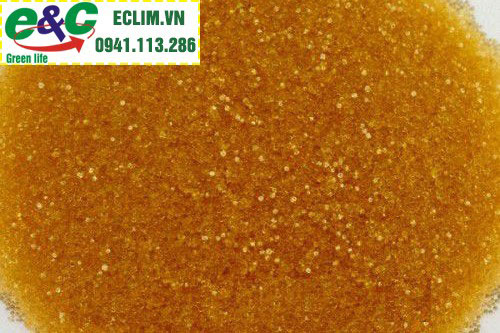Call now 0941.113.286 to get advice on the best products from ECLIM.

Anions have the ability to absorb positively charged ions (cationites) and remove negatively charged ions (anionites).
The beads are made of polymer and inside contain resin created by condensation of styrene. This is the bridge between the insoluble polymer (hydrocarbon network electrostatically bonded between ionizable molecules) and the 3-dimensional structure inside the resin. Resin beads have a structure with many pores.
These are plastic beads with a diameter of about 0.5 - 1mm, yellow or light brown in shape and have a relatively large expansion if soaked in water for a period of time. The optimal temperature for strongly activated particles is from 20 - 50 o C (heat resistant) and can withstand high oxidation levels.
With long-term use, the original color of the seeds will often fade and turn dark.
Determined through the method of exchanging beads with only the active ingredient when the solution flows through an exchange column containing beads. Usually the exchange reaction is a reversible reaction. However, the seeds will tend to "age" due to exposure to many strong oxidants when flowing through the exchange column.
When the solution to be exchanged flows through an exchange column packed with anion particles, a chemical substitution reaction takes place. Substitution according to the repulsive reaction properties of metal ions present in the exchange solution between positively/negatively charged ions.
Strong metal ions will repel weaker metal ions. Based on the exchange reaction properties of the metal, there will be an order of priority for exchange through the particle (selectivity).
- Strong basic anion (RNH 3 - OH- radical): These are strong alkaline exchange particles that dissociate OH - in water, absorb negative ions in solution and can work in different pH environments. When this group regenerates seeds, they use NaOH to regenerate the OH - group .
- Weak basic anions: These are weak alkaline exchange particles with the exchange radical NH 2 , neutral pH and the ability to remove negative ions in water.
- Amphoteric basic anion: A particle capable of exchanging all impurities in water and the presence of ions in water.
5. How to use Anion resin beads - water filtration material
Water will be allowed to flow through the exchange column. Strong metal ions of Ca, Mg, Na, K will be retained. The dirt will be replaced by H + ions attached to the grain surface. The solution is now an acidic mixture between H + ion molecules and ion molecular impurities present in the water.
The anion column is now an acid exchange column and the anion beads will remove negatively charged molecular impurities. Dirt from the water will continue to replace the OH - molecular group and will combine with H + ions to form deionized water. When treating water, anions will bond with Ca 2+ and Mg 2+ ions and attract other heavy metals in hard water and release Na into the water, thus softening the water.
After each use of plastic beads, it is necessary to regenerate them so that they can be reused the next time. If the seeds are not regenerated, the exchange efficiency of the seeds will decrease, and water treatment will not be effective because the exchange surface of the seeds is no longer effective. The regeneration process includes 4 steps.
- Step 1: Backwash
Allow water to flow back through the bottom of the column to expand the material and help dislodge dirt and other insoluble materials. Eliminate empty air pockets in the column and reposition the resin beads. When dirt and other insoluble substances accumulate for a long time in the exchange column, they will cause blockage and poor circulation of water flowing through the column, increasing the exchange pressure in the column, so backwashing will help to clean the column. reduce these conditions.
- Step 2: Soak the plastic beads in washing solution
The exchange resin beads will be soaked in NaOH solution to remove anions that have been trapped on the surface of the beads during the filtration process and return the resin beads to their original new state before exchange.
- Step 3: Wash slowly
After the seed regeneration process, wash slowly by continuing to use NaOH to regenerate and remove impurities from the system.
- Step 4: Wash quickly
Quick washing is a test step to re-test the exchange process of particles after being regenerated and determine the effectiveness of column washing.

0 comments